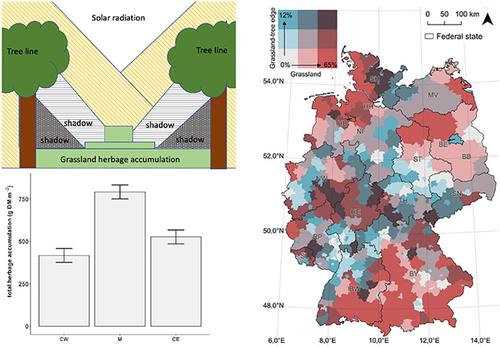当前位置:
X-MOL 学术
›
Ann. Appl. Biol.
›
论文详情
Our official English website, www.x-mol.net, welcomes your feedback! (Note: you will need to create a separate account there.)
Impacts of cutting frequency and position to tree line on herbage accumulation in silvopastoral grassland reveal potential for grassland conservation based on land use and cover information
Annals of Applied Biology ( IF 2.6 ) Pub Date : 2021-02-02 , DOI: 10.1111/aab.12681 Andrea Schmiedgen 1, 2 , Martin Komainda 1 , Katja Kowalski 3 , Patrick Hostert 3, 4 , Bettina Tonn 1, 2 , Manfred Kayser 1, 5 , Johannes Isselstein 1, 2
Annals of Applied Biology ( IF 2.6 ) Pub Date : 2021-02-02 , DOI: 10.1111/aab.12681 Andrea Schmiedgen 1, 2 , Martin Komainda 1 , Katja Kowalski 3 , Patrick Hostert 3, 4 , Bettina Tonn 1, 2 , Manfred Kayser 1, 5 , Johannes Isselstein 1, 2
Affiliation

|
In agricultural grassland, high herbage utilisation efficiency (HEFF), which is the proportion of gross live-green herbage production that is utilised before entering senescence, is ensured by frequent defoliation. The decision upon which defoliation frequency to apply depends on the farming intensity. Assuming a reduced total herbage accumulation near trees in silvopastoral systems, frequent defoliations with high HEFF become less worthwhile—at least in specific spatial configurations. This makes an extensive management near trees an interesting option because it promotes other grassland-related ecosystem services such as biodiversity. The present study first analysed the interaction between defoliation frequency and position to trees on the total, dead and live herbage accumulation and the HEFF at two silvopastoral sites with short-rotation coppices in Germany. In addition, the total grassland–tree interface in Germany was assessed from land use and land cover maps of Germany based on satellite data to approximate the potential of grassland extensification near trees. The total herbage accumulation near trees declined by up to 41% but the HEFF was not affected by the position. Consequently, any intensification is not paid-off by adequate productivity and herbage quality in terms of HEFF and tree-related losses in herbage accumulation are expected up to a distance of 4.5–6 m. Applying a 4.5 m border on satellite data, we found that up to 4.4% (approximately 2200 km2) of the total grassland area in Germany is at a tree interface and potentially suitable for extensification. These findings indicate substantial potential for biodiversity conservation in grasslands with low trade-off for high-quality yield.
中文翻译:

林牧草地砍伐频率和位置对牧草积累的影响揭示了基于土地利用和覆盖信息的草地保护潜力
在农业草地中,高牧草利用效率(HEFF),即进入衰老前利用的活绿色牧草总产量的比例,是通过频繁落叶来确保的。应用哪种落叶频率的决定取决于耕作强度。假设林牧系统中树木附近的总草本积累减少,高 HEFF 的频繁落叶变得不那么值得——至少在特定的空间配置中。这使得在树木附近进行广泛的管理成为一个有趣的选择,因为它促进了其他与草地相关的生态系统服务,例如生物多样性。本研究首先分析了落叶频率与总树木位置之间的相互作用,死和活的牧草积累和 HEFF 在德国两个具有短轮换灌木林的林牧地点。此外,基于卫星数据,根据德国土地利用和土地覆盖图评估了德国的总草地 - 树木界面,以近似树木附近草地扩展的潜力。树木附近的牧草总量下降了 41%,但 HEFF 不受该位置的影响。因此,就 HEFF 而言,任何集约化都无法通过足够的生产力和牧草质量获得回报,预计在 4.5-6 m 距离内牧草积累中与树木相关的损失。在卫星数据上应用 4.5 m 边界,我们发现高达 4.4%(约 2200 km 德国的总草地-树木界面是根据德国的土地利用和土地覆盖图根据卫星数据评估的,以近似树木附近草地扩展的潜力。树木附近的牧草总量下降了 41%,但 HEFF 不受该位置的影响。因此,就 HEFF 而言,任何集约化都无法通过足够的生产力和牧草质量获得回报,预计在 4.5-6 m 距离内牧草积累中与树木相关的损失。对卫星数据应用 4.5 m 边界,我们发现高达 4.4%(约 2200 km 德国的总草地-树木界面是根据德国的土地利用和土地覆盖图根据卫星数据评估的,以近似树木附近草地扩展的潜力。树木附近的牧草总量下降了 41%,但 HEFF 不受该位置的影响。因此,就 HEFF 而言,任何集约化都无法通过足够的生产力和牧草质量获得回报,预计在 4.5-6 m 距离内牧草积累中与树木相关的损失。对卫星数据应用 4.5 m 边界,我们发现高达 4.4%(约 2200 km 就 HEFF 而言,任何集约化都无法通过足够的生产力和牧草质量获得回报,预计在 4.5-6 m 距离内,牧草积累中与树木相关的损失。对卫星数据应用 4.5 m 边界,我们发现高达 4.4%(约 2200 km 就 HEFF 而言,任何集约化都无法通过足够的生产力和牧草质量获得回报,预计在 4.5-6 m 距离内,牧草积累中与树木相关的损失。对卫星数据应用 4.5 m 边界,我们发现高达 4.4%(约 2200 km2 ) 德国草原总面积的 3 分位于树木交界处,可能适合扩展。这些发现表明草原生物多样性保护具有巨大潜力,但对高质量产量的权衡却很低。
更新日期:2021-02-02
中文翻译:

林牧草地砍伐频率和位置对牧草积累的影响揭示了基于土地利用和覆盖信息的草地保护潜力
在农业草地中,高牧草利用效率(HEFF),即进入衰老前利用的活绿色牧草总产量的比例,是通过频繁落叶来确保的。应用哪种落叶频率的决定取决于耕作强度。假设林牧系统中树木附近的总草本积累减少,高 HEFF 的频繁落叶变得不那么值得——至少在特定的空间配置中。这使得在树木附近进行广泛的管理成为一个有趣的选择,因为它促进了其他与草地相关的生态系统服务,例如生物多样性。本研究首先分析了落叶频率与总树木位置之间的相互作用,死和活的牧草积累和 HEFF 在德国两个具有短轮换灌木林的林牧地点。此外,基于卫星数据,根据德国土地利用和土地覆盖图评估了德国的总草地 - 树木界面,以近似树木附近草地扩展的潜力。树木附近的牧草总量下降了 41%,但 HEFF 不受该位置的影响。因此,就 HEFF 而言,任何集约化都无法通过足够的生产力和牧草质量获得回报,预计在 4.5-6 m 距离内牧草积累中与树木相关的损失。在卫星数据上应用 4.5 m 边界,我们发现高达 4.4%(约 2200 km 德国的总草地-树木界面是根据德国的土地利用和土地覆盖图根据卫星数据评估的,以近似树木附近草地扩展的潜力。树木附近的牧草总量下降了 41%,但 HEFF 不受该位置的影响。因此,就 HEFF 而言,任何集约化都无法通过足够的生产力和牧草质量获得回报,预计在 4.5-6 m 距离内牧草积累中与树木相关的损失。对卫星数据应用 4.5 m 边界,我们发现高达 4.4%(约 2200 km 德国的总草地-树木界面是根据德国的土地利用和土地覆盖图根据卫星数据评估的,以近似树木附近草地扩展的潜力。树木附近的牧草总量下降了 41%,但 HEFF 不受该位置的影响。因此,就 HEFF 而言,任何集约化都无法通过足够的生产力和牧草质量获得回报,预计在 4.5-6 m 距离内牧草积累中与树木相关的损失。对卫星数据应用 4.5 m 边界,我们发现高达 4.4%(约 2200 km 就 HEFF 而言,任何集约化都无法通过足够的生产力和牧草质量获得回报,预计在 4.5-6 m 距离内,牧草积累中与树木相关的损失。对卫星数据应用 4.5 m 边界,我们发现高达 4.4%(约 2200 km 就 HEFF 而言,任何集约化都无法通过足够的生产力和牧草质量获得回报,预计在 4.5-6 m 距离内,牧草积累中与树木相关的损失。对卫星数据应用 4.5 m 边界,我们发现高达 4.4%(约 2200 km2 ) 德国草原总面积的 3 分位于树木交界处,可能适合扩展。这些发现表明草原生物多样性保护具有巨大潜力,但对高质量产量的权衡却很低。



























 京公网安备 11010802027423号
京公网安备 11010802027423号